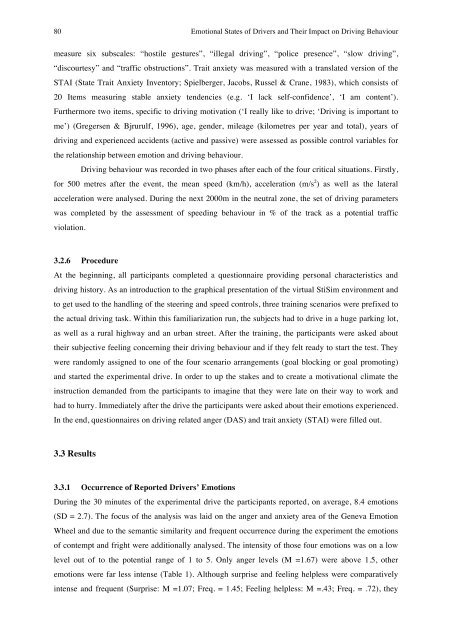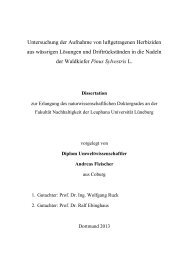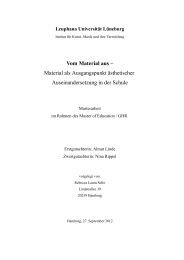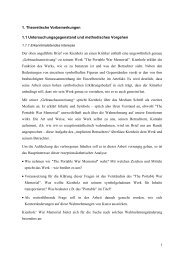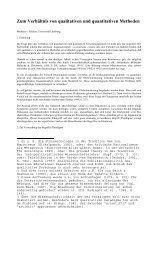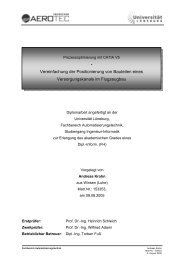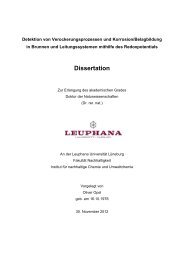Determinants of Emotional Experiences in Traffic Situations ... - OPUS
Determinants of Emotional Experiences in Traffic Situations ... - OPUS
Determinants of Emotional Experiences in Traffic Situations ... - OPUS
You also want an ePaper? Increase the reach of your titles
YUMPU automatically turns print PDFs into web optimized ePapers that Google loves.
80 <strong>Emotional</strong> States <strong>of</strong> Drivers and Their Impact on Driv<strong>in</strong>g Behaviour!<br />
measure six subscales: “hostile gestures”, “illegal driv<strong>in</strong>g”, “police presence”, “slow driv<strong>in</strong>g”,<br />
“discourtesy” and “traffic obstructions”. Trait anxiety was measured with a translated version <strong>of</strong> the<br />
STAI (State Trait Anxiety Inventory; Spielberger, Jacobs, Russel & Crane, 1983), which consists <strong>of</strong><br />
20 Items measur<strong>in</strong>g stable anxiety tendencies (e.g. ‘I lack self-confidence’, ‘I am content’).<br />
Furthermore two items, specific to driv<strong>in</strong>g motivation (‘I really like to drive; ‘Driv<strong>in</strong>g is important to<br />
me’) (Gregersen & Bjrurulf, 1996), age, gender, mileage (kilometres per year and total), years <strong>of</strong><br />
driv<strong>in</strong>g and experienced accidents (active and passive) were assessed as possible control variables for<br />
the relationship between emotion and driv<strong>in</strong>g behaviour.<br />
Driv<strong>in</strong>g behaviour was recorded <strong>in</strong> two phases after each <strong>of</strong> the four critical situations. Firstly,<br />
for 500 metres after the event, the mean speed (km/h), acceleration (m/s 2 ) as well as the lateral<br />
acceleration were analysed. Dur<strong>in</strong>g the next 2000m <strong>in</strong> the neutral zone, the set <strong>of</strong> driv<strong>in</strong>g parameters<br />
was completed by the assessment <strong>of</strong> speed<strong>in</strong>g behaviour <strong>in</strong> % <strong>of</strong> the track as a potential traffic<br />
violation.<br />
3.2.6 Procedure<br />
At the beg<strong>in</strong>n<strong>in</strong>g, all participants completed a questionnaire provid<strong>in</strong>g personal characteristics and<br />
driv<strong>in</strong>g history. As an <strong>in</strong>troduction to the graphical presentation <strong>of</strong> the virtual StiSim environment and<br />
to get used to the handl<strong>in</strong>g <strong>of</strong> the steer<strong>in</strong>g and speed controls, three tra<strong>in</strong><strong>in</strong>g scenarios were prefixed to<br />
the actual driv<strong>in</strong>g task. With<strong>in</strong> this familiarization run, the subjects had to drive <strong>in</strong> a huge park<strong>in</strong>g lot,<br />
as well as a rural highway and an urban street. After the tra<strong>in</strong><strong>in</strong>g, the participants were asked about<br />
their subjective feel<strong>in</strong>g concern<strong>in</strong>g their driv<strong>in</strong>g behaviour and if they felt ready to start the test. They<br />
were randomly assigned to one <strong>of</strong> the four scenario arrangements (goal block<strong>in</strong>g or goal promot<strong>in</strong>g)<br />
and started the experimental drive. In order to up the stakes and to create a motivational climate the<br />
<strong>in</strong>struction demanded from the participants to imag<strong>in</strong>e that they were late on their way to work and<br />
had to hurry. Immediately after the drive the participants were asked about their emotions experienced.<br />
In the end, questionnaires on driv<strong>in</strong>g related anger (DAS) and trait anxiety (STAI) were filled out.<br />
3.3 Results<br />
3.3.1 Occurrence <strong>of</strong> Reported Drivers’ Emotions<br />
Dur<strong>in</strong>g the 30 m<strong>in</strong>utes <strong>of</strong> the experimental drive the participants reported, on average, 8.4 emotions<br />
(SD = 2.7). The focus <strong>of</strong> the analysis was laid on the anger and anxiety area <strong>of</strong> the Geneva Emotion<br />
Wheel and due to the semantic similarity and frequent occurrence dur<strong>in</strong>g the experiment the emotions<br />
<strong>of</strong> contempt and fright were additionally analysed. The <strong>in</strong>tensity <strong>of</strong> those four emotions was on a low<br />
level out <strong>of</strong> to the potential range <strong>of</strong> 1 to 5. Only anger levels (M =1.67) were above 1.5, other<br />
emotions were far less <strong>in</strong>tense (Table 1). Although surprise and feel<strong>in</strong>g helpless were comparatively<br />
<strong>in</strong>tense and frequent (Surprise: M =1.07; Freq. = 1.45; Feel<strong>in</strong>g helpless: M =.43; Freq. = .72), they


